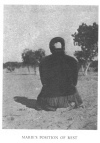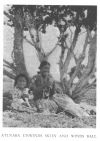
Spider Woman, by Gladys A. Reichard, [1934], at sacred-texts.com

Spider Woman, by Gladys A. Reichard, [1934], at sacred-texts.com
Marie, arriving early the next morning, finds my hands decorated. I am wearing my favorite blue bandana folded thickly tied around my thumb joint and fastened about my wrist with a square knot I achieved with the aid of my teeth. A neat strip of adhesive around my index finger protects the hangnail, caused by the dryness of the air, from catching into the threads. When Maria Antonia comes in, she laughs quietly but mirthfully into her lap, covering her mouth with her hand. She shows me a thick callus on the bone of her thumb. I respect that scar—it is a monument to the scores of beautiful blankets Maria Antonia has woven. And now I know that I am not alone in my infirmity. The pain on my own blue-bandaged prominence is less poignant; it has become an honorable scar. I shall try to go forward to the callus ideal.
The next two days the adhesive rings advance progressively. If I haven't an index finger hangnail to catch into the warps, I develop one on my middle finger. Obstruct that one, and there is one on the third finger. At its most ornamental stage my right hand has a bandana and three adhesive rings on the first joints. Those of the family who drop in to see my progress—that means the entire family—smile sympathetically with me. Rarely do they laugh at me. I accomplish more each day, the work looks better; I achieve it with greater ease.

Click to enlarge
MARIE CARDS—

Click to enlarge
—AND SPINS

Click to enlarge
MARIE SHOWS HOW TO HOLD BATTEN AND COMB

Click to enlarge
MARIE PULLS THE HEALD
We stop weaving for several days because there is no more white or gray yarn. Marie and I take time to card, my contribution not adding much to the accumulating pile of fluffiness. The position necessary for carding has my hands cramped in less time than it takes to card a single portion. The next day, however, I can keep at it half an hour. Ninaba and Maria Antonia take their turns with the extra pair of towcards when they come in to visit. I try spinning too when Marie takes to it. It is not a difficult operation although it is not easy to obtain creditable results. Spinning, like bicycle riding, is an art which cannot be taught. It can be "shown"; after that only practise will bring forth a satisfactory result.
Marie tells me—for we have ample opportunity for conversation now—that not all women can spin, even though they are good weavers. They procure their yarn from friends, some of whom specialize in warp yarn, and others in weft. All, doubtless, know how to card, but it is not a favorite diversion. If carding cramps my hands, it is no different with theirs. They are more accustomed, but hands and shoulders become weary, for it is hard work. Besides it is dirty. Contrary to the common notion, wool is not usually cleaned before it is carded. Washing mats it and makes it difficult to card. The carding itself removes a great amount of dirt. Sand and other dirt loosened by the teeth of the towcards fall out of the wool. Before carding, it may be a yellow lumpy matted mass. It comes forth from the cards of an expert in a white fluffy shapely rectangular pad. I like wool in almost any state or form, but it is most attractive at this stage.
I try my little stint of carding and spinning but soon leave Marie to visit the other members of the family, who are doing attractive things. Red-Point is a chanter. That is to say,
he knows medicine and can sing for days and nights on end the orderly rites which the Navajo believe cure disease, avert bad luck, and bring good. The chants which I think of as charms include singing, administration of herbal medicine, and application of sacred objects to the body. Among the most sacred are the sand-paintings, made at particular times during the chant, by artists allowing colored sands to sift through their fingers in the most incredible and regular manner. The result is an astonishing composition of symbolical figures in the softest shades of black, blue, yellow, white, red, and pink on a pale tan background. The artists themselves need skill, but they need not know the pictures. That is the duty of the chanter who directs them. The art, a beautiful and unusual one, is evanescent. Paintings which take hours to make are, by the rules of the chant, ruined in twenty minutes, removed in less than half an hour after their completion.
For these reasons there is considerable interest on the part of whites to preserve this transitory art. Red-Point, whose fame has spread far, has learned to execute the paintings on paper with tempera. At work he fascinates me even as the weavers. He has a drawing board on which he fastens his paper with thumb tacks. He spreads his colors and brushes on an inverted sheepskin beside him, lays the drawing board on the ground, takes his place before it, legs crossed in front of him, and paints. He is sixty-seven years old, but his hand is steady. The technique is one learned late in life, but his lines are straight and firm. Leisurely and pridefully he works, explaining the figures to me as they grow. He occasionally pauses for a smoke and a rest, and I wonder how he ever gets a painting finished. These people by some subtle alchemy
have compounded calmness and competence in a blend whose name is accomplishment. The secret of their formula, I suspect, is that they guard against the impurity of fussiness.
After staying an hour or so with Red-Point I proceed to Atlnaba's house. She has visited me briefly to see how I am coming along, but her own interest has reached a climax. For over a year she has been working on a large tapestry. Contrary to the usual custom whereby women weave the patterns in their heads or in their mind's eye, she is copying as accurately as she can the exact details of a framed sand-painting which stands on the ground resting against the post of her loomframe. It is one of Red-Point's paintings, the Sun's House. She has chosen to use a soft gray background. In the center a large portion consisting of four wide stripes of yellow, green, black, and white represents the Sun's House. Within the yellow stripe are the houses of Sun, Moon, Black Wind, and Yellow Wind, each with a snake as guardian and with a rainbow border. The center portion is surrounded by a rainbow of blue and red, each stripe outlined in white.
At the east a yellow cloud bordered with a red and blue rainbow and set with four sundogs of the same colors represents the house of the Sun People. Five of them show their heads peeping above their house. A similar black cloud at the south represents the Sky People, a blue one at the west the Water People, a pink one at the north the Summer People. These People are all deities of a sort. In addition to the cloud at the north are the Sun and Moon at the right, Black and Yellow Winds at the left. Above each rise yellow, green, black, and white clouds in the form of a triangle. Each series is surmounted by a bird of different plumage. A bird also rests on
the head of the center Summer deity, making five birds across the top.
Atlnaba has executed in her weaving every detail of this complicated picture; she has omitted no outline, not a feather of a variegated bird. I watch her today even as I watched her the first day I saw her, with increasing amazement at her dexterity. She has woven the black border from the top down and now has about a thumb-joint length of the background to work in from the bottom. It takes longer to put in this last portion than to do any similar piece of the weaving of the entire blanket. I cannot stay until she has it finished, but it is not because I am bored. The movements of her clever fingers are a source of constant admiration to me, and I am never weary of watching them.
I have waited two days for white and gray yarn. They have not been wasted. I have been "seeing Navajo life," learning Navajo words. I have been to Ganado for towcards and dyes and have taken the teasing my white friends, the traders, consider necessary each time I report to them. I do not weave on the morrow either. Atlnaba finishes her tapestry. I photograph it. I take her, the rug neatly wrapped in unbleached muslin, and such of the family as the Ford will hold to Ganado; Atlnaba and Curley's-Son, Marie, Tom and their two little boys make up what I innocently regard as a capacity load for a small, a very small, touring car.
When we get to Ganado we hear there is a Navajo assembly and exhibition at Kinlichi, seven miles to the northeast. We decide to go along with two carloads of our white friends. We see many people, Navajo and white, play a gambling game with some old Navajo men, and before sundown start for home. Here are two boys, relatives of Tom and Curley's—

Click to enlarge
SUN'S HOUSE BLANKET

Click to enlarge
SUN'S HOUSE DETAIL

Click to enlarge
MARIE'S POSITION OF REST

Click to enlarge
ATLNABA UNWINDS SKEIN AND WINDS BALL
[paragraph continues] Son, who have no way of returning. They came in a truck which continued on its way to Gallup. "There is always room for one more," and we take one, our white friends the other. We did our trading at Ganado before we left for the exhibition, and we stop for our goods. We let out our hitch-hiker and take on three sacks of flour, one of potatoes, two watermelons, and a pack of miscellaneous groceries, coffee, sugar, canned tomatoes, and the like. I leave it to the Navajo to get the goods and themselves in, and somehow they do so and never get any legs or skirts in the gears either.
Marie has left the yarn spun and wound into skeins with her mother, who has washed it and dried it. Tomorrow I can get back to my weaving.